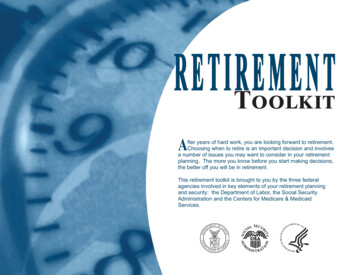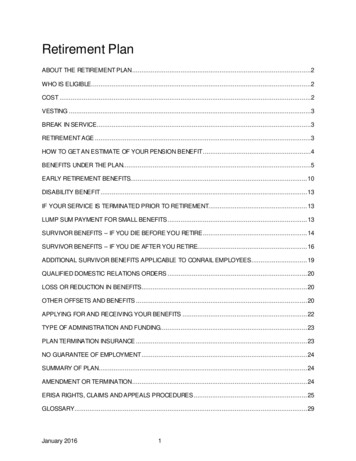
Transcription
Retirement Counselors are Here to Help1.800.633.5461 - www.SERS.pa.govSERS’ mission is to provide retirement benefits and services to our members through soundadministration and prudent investments.SERS’ BoardChairman, David R. Fillman – AFSCME Council 13 Executive DirectorGlenn E. Becker – Managing Director, Birch Run InvestmentsJohn M DiSanto – State SenatorDan B. Frankel – State RepresentativeVincent J. Hughes – State SenatorGregory K Jordan – Former Executive Director Senate Appropriation CommitteeMary A. Soderberg – Former Budget Secretary and Retired MemberGregory C. Thall – Attorney and Special Assistant to the Budget SecretaryMichael G. Tobash – State RepresentativeJoseph M. Torsella – State TreasurerRichard Vague – Acting Secretary of Banking and SecuritiesSERS is not responsible for any inaccurate or incomplete information provided to you by your employeror other entity about the SERS benefit. Accordingly, it is very important that you read all SERS-providedinformation. If you have questions about SERS benefits or inconsistencies between information providedby SERS and another entity, please contact a SERS Retirement Counselor.
CONFIDENTIALITY OF SERS MEMBER INFORMATIONAll SERS retirement counseling matters are confidential, including your personalized retirementestimates.Certain information about you and your SERS retirement benefit are subject to releasepursuant to a subpoena or a Right-To-Know Law request. That information includes, amongother things, your SERS-participating employer, years of service, and retirement-coveredcompensation. As a result of a Pennsylvania Supreme Court Order, all home addressesgenerally are considered to be private information. If you are a judge or law enforcementofficer, your home address is specifically exempted from release under the Right-ToKnow Law. If you have any documented personal security issues or Protection from Abuse(PFA) orders, you should send a copy of your written statement or court order detailingthe specific threat to your personal security to the State Employees’ Retirement System,30 North 3rd Street, Suite 150, Harrisburg PA 17101-1716 Attn: SERS-Office of MemberServices or e-mail it to ra-sersretc@pa.gov.We may provide certain information from your SERS record to a SERS-participatingemployer upon the employer’s request to be used for business purposes.If You Want Us to Release Information to a Third PartyIf you choose, you may authorize us to release certain information from your SERS record to a thirdparty. Your authorization must be in writing, dated, and signed by you. You can access an Authorizationto Release Account Information form or Authorization to Release Death Beneficiary Information form onSERS’ website at www.SERS.pa.gov, or request the forms by calling 1.800.633.5461.Beneficiary InformationAbsent a properly completed authorization form, information about your designated beneficiary willbe released to no one but you, except as required by subpoena or other court order before a paymentis issued to that beneficiary. However, death beneficiary information will be released pursuant to asubpoena.
TABLE OF CONTENTSHow your defined benefit plan works:About SERS01Membership01Employee Contributions02Service Credit & Eligibility Points03Multiple Service04Class of Service05Purchasing Service08Transferring Into And Out Of LawEnforcement And Security Positions09Retirement Benefit Forfeiture10Appeals & Hearings10State Police Retirement Benefits11Eligibility for Monthly Pension Payments12Pension Benefit Limitations12Basic Pension Calculation13Pension Payment Options14Eligibility for a SERS Disability Retirement Benefit18Domestic Relations & Support Orders18Leaving State Employment20Pension Death Benefit21Taxes22Return to Service24SERS Social Security Integration (SSI) Coverage26It’s Never too Early to Prepare for Retirement:Retirement Planning29Regional Counseling Centers33Deferred Compensation Plan36
DEFINEDBENEFITPLANal PensiontionidTraHOW YOUR SERS DEFINEDBENEFIT PLAN WORKS:
ABOUT SERSEstablished in 1923, SERS is one of the nation’sAdministration of the SERS fund and theoldest and largest statewide retirement plans forfiduciary responsibility for its management ispublic employees. Acting on behalf of the Statevested in an 11-member board.Employees’ Retirement Board, SERS administersfour retirement plans - a defined benefit pensionThe investment plan benefits are fundedplan, a defined contribution investment plan,through a combination of member and employera hybrid plan that is a combination of thecontributions, and the investment earnings frompension and investment plans, and a voluntarythe participant’s personal investment choices.supplemental Deferred Compensation Plan.Day-to-day management of SERS is theThe pension, investment, and hybrid plans areresponsibility of the executive director who, withadministered according to the State Employees’the approval of the board, employs needed staff,Retirement Code.and contracts for professional services.The pension benefits are funded throughThe supplemental Deferred Compensation Plan isa combination of member and employerfunded by a participant’s voluntary contributionscontributions, and investment earnings fromand the investment earnings from their personalthe professionally managed SERS Fund.investment choices. See pg. 34 for moreinformation.MEMBERSHIPWelcome to the State Employees’ Retirement System. As part of your public employment, you receive aretirement benefit. While you may not be thinking about it right now, there are some things you shouldconsider for your future. This handbook outlines your retirement benefit and your responsibilities.With a few exceptions specified in the State Employees’ Retirement Code, if you are a permanent fulltime or permanent part-time state employee or an employee of certain independent agencies, you area mandatory SERS member. Your employer automatically enrolled you in SERS when you were hired,began withholding employee contributions, and started paying employer contributions toward your SERSretirement benefit.If you are a part-time employee paid by the hour or the day, you are required to join SERS after earningcompensation for 750 hours or 100 days in a calendar year.Retirement is not necessarily a “set it and forget it” exercise, but it doesn’t have to be complicated. Thechoices you make now are important and will benefit you in the future. Please take the time to reviewthis material. We have plenty of resources available to you to help you along the way. Whether in-person,by phone or online, SERS is available to answer all of your SERS retirement-related questions.SERS Defined Benefit Plan Member Handbook - 1
EMPLOYEE CONTRIBUTIONSYou contribute a percentage of your pay toward your SERS pensionbenefit each pay period. Your employer automatically deducts yourcontribution from your pay and forwards it to us. The amount youcontribute is set by the State Employees’ Retirement Code and islargely determined by your class of service, with rates currentlyvarying between 5% and 9.3% of your pay.If you first entered SERS membership after January 1, 2011, yourcontribution rate may change depending on the performance of theSERS fund over time, according to the “shared-risk”/”shared-gain”provision in the Retirement Code. Your rate may change by 0.5%Can I take a loanfrom mySERS retirementplans?No. You may receive moneyfrom your SERS pensiononly after leaving stateemployment.every three years and by no more than 2% overall.Your pension benefit contributions earn 4% statutory interestcompounded annually.As a member of the defined benefit plan, you will receive an annualpension statement each March listing your contributions toward yourpension and the interest earned on those contributions in the prior2017 Contributionsto the SERS Fund 383millionemployeescontributedcalendar year and over your entire membership with SERS.Please review your statements for accuracy and file them with yourother important records. Your statements are helpful tools in planningfor retirement and may be useful in calculating your federal incometax liability when you retire or leave state service.Your contributions toward your pension benefit, excluding those made 1.9billionemployerscontributedfor the purchase of service, are tax-deferred and reduce your federallytaxed earnings each year. They will be subject to federal taxationwhen you receive them in the form of pension payments. 3.9billioninvestmentscontributed2 - SERS Defined Benefit Plan Member Handbook
SERVICE CREDIT AND ELIGIBILITY POINTSYour years of credited service are a major component in the calculation that determines the amount ofyour pension. Eligibility points determine when you qualify for a pension.When you work for a SERS-participating employer and we receive employee and employer contributionstoward your pension for the time worked, we credit your member record with the service.In general, most SERS members are credited with one year of service and one eligibility point for every1,650 hours worked in a calendar year. If you work more than 1,650 hours in a calendar year, you earnjust one year of service credit and one eligibility point. If you work less than 1,650 hours in a calendaryear, you are credited with a fraction of a year’s credit and a fraction of an eligibility point based on thehours you worked.While in most cases your total service credit and eligibility points will match, there are limited instanceswhen they will not. For instance, if you take USERRA military leave, you will earn eligibility points forthat leave time; however, you will not earn service credit unless you purchase the service after youreturn from leave.Work Completed on a Term BasisIf you are employed on a term basis, for instance as a member of the legislature, or as a judge,magisterial district judge, department head, or faculty member, your service is credited based on yourterm in office or the term of your employment.Work Completed Before 1976If you worked prior to January 1, 1976, special rules regarding your service credit may apply. Contacta SERS retirement counselor to discuss your specific circumstances.Long-Service PensionSupplementIf you retire with 41 or moreyears of credited service, youare eligible for a supplementalbenefit that increases yourmaximum annual pension by2% for each additional yearto a maximum 110%.Total Years ofCredited ServicePercentageof MaximumAnnual Pension35-40100%41102%42104%43106%44108%45 110%SERS Defined Benefit Plan Member Handbook - 3
MULTIPLE SERVICEIf you have previously worked for a public education employerin Pennsylvania or have credited service with the Public SchoolEmployees’ Retirement System (PSERS), you may be able to combineyour school and state service toward one pension when you retire.This is called “multiple service.”Have you everworkedfor a PA publicschool district?Your decision to elect multiple service is voluntary. To elect multipleservice, you must be actively contributing toward a SERS pension andyou must elect within the established timeframes.It’s possible that one combined pension calculated on your total service credit from both systems willbe larger than the payments you would have received from each system individually. When you electmultiple service, your pension is paid by the retirement system in which you were last an active member.You must elect multiple service within 365 days of joining SERS. If you do not elect within thefirst year, you will lose your opportunity to do so unless you leave state service for two weeks or moreand later return. In that case, you would have 365 days from the date you re-join SERS to make theelection. The election of multiple service may include the purchasing of past service that is required tocomplete the election.If you ever worked in a Pennsylvania public school system or for another public education employer inPennsylvania – such as an intermediate unit, a community college, a school associated with the StateSystem of Higher Education, or Penn State, for example – you may already be a member of PSERS. Yourwork could be in any capacity: teacher, counselor, aide, administrator, physical plant manager, bus driver,cafeteria worker, or other positions. However, you still must elect multiple service within the establishedtimeframes.If you worked for any of these types of organizations but did not belong to PSERS, you still may be ableto purchase the service and elect multiple service.If you have questions concerning multiple service such as eligibility, the effect it may have on yourtotal pension, or any other questions, please contact your Regional Retirement Counseling Center at1.800.633.5461.4 - SERS Defined Benefit Plan Member Handbook
If I leave stateservice, canI continue tocontribute to mySERS retirementplans on anindividual basis?No, all contributions mustbe made through a SERSparticipating employer.CLASS OF SERVICEYour SERS class of service is among the most important factors inyour pension calculation and therefore is one of the most importantpieces of information to know about your pension plan. It is setby the Retirement Code and determines how quickly your pensiongrows, how much you contribute toward your pension, the age atwhich you can retire without penalty, and how long you must workbefore becoming eligible for monthly pension payments, amongother things.SERS has more than a dozen classes of service. Your class ofservice is determined largely by when you became a SERS member.Generally, if you first entered SERS membership:In 2017SERS retired Between January 1, 2011, and December 31, 2018,or you were hired on or after January 1, 2019 into4,775a law enforcement or security position (state police,membersand welcomedcorrections, etc.) after that period you entered SERS inthe A-3 class of service, with a 45-day window to join9,901the A-4 class.new members 239,266MEMBERS129,473Before January 1, 2011, you are a member of the Aor AA class of service.While there are other classes of service that cover legislatorselected before December 2010, judges, and magisterial districtjudges; the most common classes of service are detailed in thefollowing table.receiving benefits102,978paying into the system6,815vested but notreceiving benefitsSERS Defined Benefit Plan Member Handbook - 5
CLASS OF SERVICEA-3Employees who became members on or after 1/1/11Who is a Memberof the ClassLegislators who became members on or after 12/1/10 butbefore 1/1/19.State police officers who became members on or after 7/1/12MemberContribution RateVestedClass A-3 members who, withinthe fi rst 45 days of SERSmembership, voluntarily electedto contribute more to earn ahigher class of service multiplier6.25% of salary9.3% of salaryYesYes1.00(x 2% in the pension formula yieldsbenefit accrual rate of 2%)1.25(x 2% in the pension formulayields benefit accrual rate of2.5%)After 10 years of serviceAfter 10 years of serviceMember Rate Can Riseif InvestmentPerformance is PoorClass of Service M ultiplierA-4Age 65 for most membersSERS NormalRetirement AgeAge 65 for most members ge 55 for corrections officers,A Delaware River Port Authority policeofficers, enforcement officers, legislators, psychiatric securityaides, a nd state police officersAge 55 for capitol police officersand p ark rangers who have 20 ormore y ears of service in those jobsEligible forUnreducedRetirement ember CanMWithdraw Contributionsupon RetirementCost to PurchaseNon-State Service ge 55 for corrections officers,A Delaware River Port Authoritypolice officers, enforcementofficers, l egislators, psychiatricsecurity aides, a nd state policeofficersAge 55 for capitol police officersand p ark rangers who have 20or more y ears of service in thosejobsSERS normal retirement age with 3years of credited serviceSERS normal retirement age with3 years of credited serviceAny age if you have 35 years ofservice and your years of serviceplus your age equals at least 92Any age if you have 35 years ofservice and your years of serviceplus your age equals at least 92Yeswith reduced monthly paymentsYeswith reduced monthly paymentsMost service based on cost toprovide benefitsMost service based on cost toprovide benefitsMilitary service based on salarywhen you became a memberMilitary service based on salarywhen you became a member6 - SERS Defined Benefit Plan Member Handbook
AMost employees who became members prior to 7/1/01 who d idnot elect AA during the specifictimeframe specified in Act 2001-95.0% of salaryAAThings to consider:Most employees who becamemembers between 7/1/01 and1/1/11Class A members who, during aspecific timeframe specified byAct 2001-9, v oluntarily elected tocontribute more to earn a higherclass of service multiplier6.25% of salaryIf you are eligible toelect membership in theoptional A-4 class, youwill lock yourself intocontributing a higherpercent of your paytoward your retirementbenefit –- more than 3%higher -- for as long asNoyou are an active memberNoof SERS.1.00(x 2% in the pension formulayields benefit accrual rate of 2%)1.25(x 2% in the pension formulayields benefit accrual rate of2.5%)After 5 years of serviceAfter 5 years of serviceAge 60 for most membersAge 60 for most members ge 50 for corrections officers,A Delaware River Port Authoritypolice officers, enforcementofficers, l egislators, psychiatricsecurity aides, a nd state policeofficers ge 50 for corrections officers,A Delaware River Port Authoritypolice officers, enforcementofficers, l egislators, psychiatricsecurity aides, a nd state policeofficersfrom your pay for yourAge 50 for capitol police officersand p ark rangers who have 20or more y ears of service in thosejobsAge 50 for capitol police officersand p ark rangers who have 20or more y ears of service in thosejobscontribution rate couldSERS normal retirement age with3 years of credited serviceSERS normal retirement age with3 years of credited serviceencouraged to considerAny age if you have 35 years ofserviceAny age if you have 35 years ofserviceYeswith reduced monthly paymentsYeswith reduced monthly paymentsIf you run into unexpectedfinancial problems inthe future, you will NOTbe able to reduce theamount of money withheldretirement benefit.As a member of eitherclass, your memberincrease.You are stronglyall of your alternatives tosave additional money forretirement beforemaking a final andbinding decision to electmembership in the A-4class.Based on salary when you becamea memberBased on salary when youbecame a memberSERS Defined Benefit Plan Member Handbook - 7
PURCHASING SERVICEmaximum annual pension will be when you retire.Types ofPurchasableServiceThere are specific situations in which the Retirement Code allowsU.S. Military serviceOne factor in the pension calculation is “years of credited service.”The more years of credited service you have, the greater youryou to purchase service and increase the amount of servicecredited toward your pension. You can only purchase service whileOut-of-stateyou are an active, contributing member of the SERS pension plan;educational serviceyou cannot purchase service after you leave state employment,while you are on a leave without pay, or if you are enrolled in thePrevious state servicestraight defined contribution plan.not currently creditedin SERS (like part-timeWhen you purchase service, you pay the contributions thatservice or optionalyou would have made toward your SERS pension. If you areservice)interested in purchasing service, call your retirement counselor at1.800.633.5461. Information here provides only a broad overview.In state educationalThere are a number of specific situations – such as purchasingservice (communityUSERRA-covered military service, for example – that require specialcollege or publicconsideration, and in every instance, the cost of any purchaseuniversity service)must be determined by SERS.Payment OptionsPurchasing service can involve significant sums of money. You haveseveral options for making payments. Lump sum Partial lump sum with payroll deductions Payroll deductions up to six years Debt to your total pension benefitSERS average active member46 yearsoldofservice12 yearsFinal and Binding DecisionSERS average retired memberAfter you submit your service purchase form, we will send you an72Invoice of Amount Due. You have 30 days from the date of theinvoice to select a payment option, to notify SERS that you nolonger wish to purchase the service, or if no response a debt isautomaticaly applied to your total pension benefit.8 - SERS Defined Benefit Plan Member Handbookyearsoldreceives 28,352per year
TRANSFERRING INTO AND OUT OF LAWENFORCEMENT AND SECURITY POSITIONSCertain law enforcement and security positions are exempt fromthe defined contribution and hybrid retirement plans. As a result,employees in those positions automatically enter the definedbenefit pension plan.If you became a SERS member on or after 1/1/19 as an employeein one of the law enforcement or security positions listed here, youautomatically became a member of the pension plan in the A-3class of service with the option to choose the A-4 class within thefirst 45 days of SERS membership.Law Enforcement/Security PositionsExempt From TheDefined Contribution& Hybrid PlansSworn Police OfficersEnforcement OfficersWildlife ConservationOfficers (Not DeputyIf you later switch jobs transferring out of a law enforcement orsecurity position, or you leave service and later return to work for aWildlife ConservationOfficers)SERS-participating employer in a non-law enforcement or securityDelaware River Portposition, you will automatically enter the hybrid plan A-5 class ofAuthority Policemenservice with the option to choose the hybrid plan A-6 class or thestraight defined contribution plan within the first 45 days of SERSPark Rangersmembership.Capitol Police OfficersIf you formerly were a member of the defined contribution orSSHE Campus Policehybrid retirement plans and then you switched into one of theOfficerslaw enforcement or security positions listed here, and then laterswitch out of that law enforcement or security position, you willautomatically return to your prior hybrid or defined contributionplan.Community CollegeCampus Police OfficersPenn State UniversityCampus Police OfficersIf you are considering switching out of a law enforcementor security job, contact a SERS retirement counselor atPolice Officers at Fort1.800.633.5461 or ra-sersretc@pa.gov to discuss your options.Indiantown GapCorrections OfficersAll other positionscurrently with age 50or 55 retirement exceptmembers of the GeneralAssemblySERS Defined Benefit Plan Member Handbook - 9
RETIREMENT BENEFIT FORFEITUREPennsylvania has laws in place to penalize publicThe Pennsylvania Constitution and Judicial Codeemployees who violate the public’s trust, byalso contain forfeiture provisions that applyforfeiting the retirement benefits of employees.to members of the judiciary who are removedThe Public Employee Pension Forfeiture Actor barred from office by the Court of Judicial1978-140 (Act 140) applies to all SERSDiscipline. Judicial forfeiture can occur even ifmembers who commit certain crimes in relationno crime has been committed.to their employment. Enforcement of Act 140is mandatory. Pennsylvania courts have heldthat SERS has no discretion in its application.It does not matter if the crime is relativelyminor compared to the value of the retirementbenefits; if Act 140 is triggered, it must beRetirement benefit forfeituredetails are available atwww.SERS.pa.govapplied.GeneralAppeal Rights1. Appeal to SERSin writing.2. If staff denies yourappeal, appeal to theAppeals Committee.3. If your appeal isdenied, appeal to theSERS Board.APPEALS AND HEARINGSIf you feel that a SERS decision about your retirement benefit iswrong and you have been denied a right or benefit to which you feelyou are entitled under the Retirement Code, you can appeal thatdecision.Appeals must be in writing, and the legal process involves strictdeadlines.Once your initial appeal is received by SERS, staff will review yourappeal and send you a response either granting your request ordenying your request. If your request is denied, you will be givenappeal rights to the SERS Appeals Committee.If the Appeals Committee does not rule in your favor, you have theright to appeal to the SERS Board.Depending on the nature of your appeal, this may involve writtenlegal arguments and an administrative hearing in Harrisburg beforean independent hearing examiner.10 - SERS Defined Benefit Plan Member Handbook
STATE POLICE RETIREMENT BENEFITSState police officers with at least 20 years of credited state police service regardless of age qualify foran alternative pension calculation.The calculation is defined by the collective bargaining arbitration award known as the DiLauro Award,and is based on years of service: State police officers with 20 – 24.99 years of state police officer service are eligible for 50% oftheir highest one-year earnings, excluding the year in which the officer leaves state service. State police officers with 25 or more years of state police officer service are eligible for 75% oftheir highest one-year earnings, excluding the year in which the officer leaves state service.Service credited for work in positions other than state police officer, including non-intervening militaryservice, is not eligible for the DiLauro Award calculation or threshold. Service for positions other thanstate police officer will be calculated according to the basic pension formula and added to the DiLauroAward calculation for one total monthly pension.The DiLauro Award calculation for state police officers who first entered SERS membership before1/1/19 includes all state service.SERS Defined Benefit Plan Member Handbook - 11
ELIGIBILITY FOR MONTHLY PENSION PAYMENTSYou are eligible to receive monthly pension payments after you are “vested” in the system.If you retire before reaching the SERS retirement age for your class of service, your pension will bereduced for early retirement. The early retirement reduction varies by class and generally increases foreach year you are away from the SERS retirement age. The earlier you retire, the greater the reduction.First Became aSERS MemberBetween 1/1/11and 1/1/19 and lawenforcement andsecurity1 hired after1/1/19VestedPeriodEligible forUnreduced PensionAt SERS retirement age afterworking 3 years65 or 55 depending onyour class of service10 yearsBefore 1/1/11(Before 1/1/10 formembers of the GeneralAssembly)SERSRetirement Age5 years60 or 50depending on your classof serviceOrAfter working 35 years when thesum of your years of service andage equals at least 92At SERS retirement ageafter working 3 yearsOrAfter working 35 yearsSworn Police Officers, Enforcement Officers, Wildlife Conservation Officers (Not Deputy Wildlife Conservation Officers), Delaware River PortAuthority Policemen, Park Rangers, Capitol Police Officers, SSHE Campus Police Officers, Community College Campus Police Officers, Penn StateUniversity Campus Police Officers, Police Officers at Fort Indiantown Gap, Corrections Officers, & all other positions currently with age 50 or 55retirement except members of the General Assembly.1PENSION BENEFIT LIMITATIONSThe Retirement Code Section 5702(c) limits the amount you may receive in annual pension paymentsto no more than the highest compensation you received during any 12-month period as an activeemployee.The Internal Revenue Code Section 415(b) limits the amount you may receive in annual pensionpayments to a specific dollar amount set by the IRS each year and adjusted according to certain factorsincluding your age at retirement and the benefit payment option you select at retirement, among others.In 2019, the base limit is 225,000; however, your total benefit will not be less than you would havereceived prior to passage of Act 2001-9.12 - SERS Defined Benefit Plan Member Handbook
BASIC PENSION CALCULATIONThe amount of your pension is determined by a calculation set forth in the Retirement Code that takesinto account your class of service multiplier, years of credited service, and final average salary. Themonthly payment you will receive is not influenced by how much your employer contributes or theperformance of SERS investments. It will, however, be reduced if you choose to retire before the SERSretirement age for your class of service.The basic pension formula is:2%XClass ofServiceMultiplierXYears ofCreditedServiceXFinalAverageSalary MaximumAnnualRetirementAllowancetogether, these comprise your“benefit accrual rate”Class of Service MultiplierYour class of service is determined by when you entered SERS membership and the work that you do.In most cases, your class of service will be determined by when you first began contributing to a SERSretirement benefit. Your class of service multiplier x 2% equals your benefit accrual rate.Years of Credited ServiceIn general, most SERS members are credited with one year of service for every 1,650 hours worked ina calendar year. If you work more than 1,650 hours, you are not credited with more than one year ofservice. If you work less than 1,650 hours, you are credited with the fraction of a year’s credit based onthe hours you worked.Final Average SalaryYour final average salary is the highest amount you earned during any “three non-overlapping periodsof four consecutive calendar quarters.” For most employees, it is the average salary of your last threeyears.SERS Defined Benefit Plan Member Handbook - 13
PENSION PAYMENT OPTIONSAfter you meet certain vesting criteria, your SERS membership entitles you to receive a pension paymentevery month for as long as you live. The annual amount of the payment is determined by the basicpension formula on the prior page and any applicable early retirement reduction. The payment is notinfluenced by how much your employer contributes or the performance of the SERS Fu
plan, a defined contribution investment plan, a hybrid plan that is a combination of the pension and investment plans, and a voluntary supplemental Deferred Compensation Plan. The pension, investment, and hybrid plans are administered according to the State Employees’











